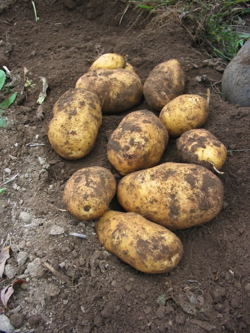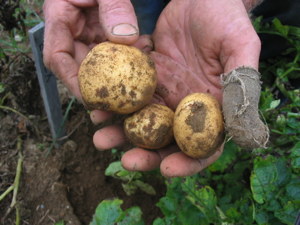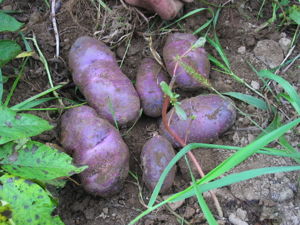One pound of seed will usually plant 5–8 row feet, depending on the variety; 10# will usually plant 50 row feet.
- Early potatoes mature in 65-80 days.
- Midseason potatoes mature in 80-90 days
- Late potatoes mature in more than 90 days
Growing Potatoes

Upon Arrival
Inspect your order as soon as it arrives. Seed potatoes may not look
appetizing: that’s ok! Sprouting, shriveling, wrinkles and minor
blemishes are normal and will not affect the performance of your potato
patch. If your seed potatoes are mushy, weeping or very moldy, please
contact us at ogs@fedcoseeds.com. If
you are not going to plant within two weeks, store seed in a dark cool
(around 40°) fairly humid place. Do not remove growing sprouts; these
are your new plants.
Chitting or Green Sprouting
You may use chitting to encourage early growth, speed development of
marketable tubers, and perhaps increase yields. Warm tubers to 65° in
the dark for about two weeks, then spread them out with most of the eyes
facing up in a warm place (60–70°) with medium light intensity
for about two weeks. This stimulates strong stubby sprouts at the bud end
that are not easily broken off.
Soil Preparation
Potatoes grow in any well-drained fertile soil. Work in compost or aged
manure, or try our house-blended Turbo-Tuber fertilizer, specially formulated to meet the needs of the
potato plant. Incidence of scab increases with use of uncomposted manure,
lime or wood ash the year of planting. Turn new ground the year before and
plant with a rye/vetch cover crop. Rotate potatoes (and other Solanaceae
family members: tomatoes, peppers and eggplants) with other plant families
in at least a 3-year or, preferably, a 4-year rotation.
Cutting Seed
Small tubers planted whole are less sensitive to seed piece decay than cut
pieces. You can cut large tubers into pieces of two ounces or more, about
the size of an egg, with at least two eyes. Many varieties have eyes
clustered at one end, so be sure to distribute eyes evenly when cutting.
Fingerling eyes spiral the length of the tuber so you may cut them into
discs or wedges. Consider treating cut seed with Myco Seed Treatment. To reduce the risk of seed piece decay, either cut
and plant in one operation or condition the cut seed pieces at
55–60° and 90% humidity for 3–4 days. Covering pieces with
damp burlap bags or towels is a way to maintain humidity levels.

Planting
Plant when the soil is 55–60° and dry enough to work easily, about
when dandelions bloom. Planting in cooler soil slows emergence and increases
the chance of seed piece decay. Planting in hot dry soil also increases the
risk of seed piece decay. Plant in furrows 4–6" deep, in rows that
allow for your style of hilling. Space new potatoes and fingerlings at
8" for maximum tuber set. Space later-season varieties at
10–12" for maximum size. One pound of seed will usually plant
5–8 row feet, depending on the variety; 10 pounds will usually plant
50 row feet. 2 oz. seed pieces 12" apart with 40" row spacing,
requires approximately 1600 lbs. (or 1000 lbs. fingerlings) per acre.
Cultivation and Hilling
Cultivate shallowly as needed during early growth. Hill when plants reach
6" and again at 12–15". After the second hilling, plants will
shade and outcompete weeds. Don’t cover plants completely when
hilling. Be gentle so as not to damage the roots. Hilling gives the plants
room to develop potatoes between the seed piece and the soil surface; it
also warms the roots, stimulating growth. Mulching plants after the second
hilling helps to retain soil moisture, control weeds and reduce incidence of
sunburn.
Irrigation
Potato plants are sensitive to small changes in soil moisture because of
their shallow (12–15") root systems. Tuber yield and size are
directly related to the amount of water available during two critical growth
stages: tuber initiation and tuber bulking. Tuber initiation is a
10–14 day period when tubers form at stolon tips. For most varieties,
the end of this stage coincides with early flowering. Tuber bulking follows
and continues until plants are mature. Lack of water tends to increase
incidence and severity of scab, and will affect yield and overall size of
the potatoes. Inconsistent water may cause growth cracks, hollow heart and
second growth. Ensure 1" of water weekly from plant emergence until two
weeks before harvest.

Harvest and Storage
Early harvest or “robbing the plant” can be done anytime you can
find potatoes, approximately 60 days after planting or 30 days after
flowering. These are new potatoes to be eaten; they will not store well.
Potato plants are mature when the vines start to senesce, or die back and
fall over. You may cut, mow, flame-kill or allow them to die naturally.
Leave tubers in the ground for 14–21 days after the vines are dead
before digging to give the skin time to “set,” and to prevent
transmission of blight spores from foliage to tubers. Harvest in cool dry
weather if possible. After a brief drying, out of direct sunlight, lightly
brush off excess dirt but don’t wash potatoes intended for storage.
Hold at 55–60° for several weeks to allow harvest injuries and
bruising to heal; then store only sound tubers at 38–40° with
85–90% relative humidity in complete darkness.
Yields
An average yield is 10 pounds harvested to 1 pound planted (10:1). Less than
6:1 probably indicates a problem, likely caused by low fertility, lack of
water, or excessive disease or insect pressure. Yields as high as 20:1 are
exceptional, but can be achieved.




